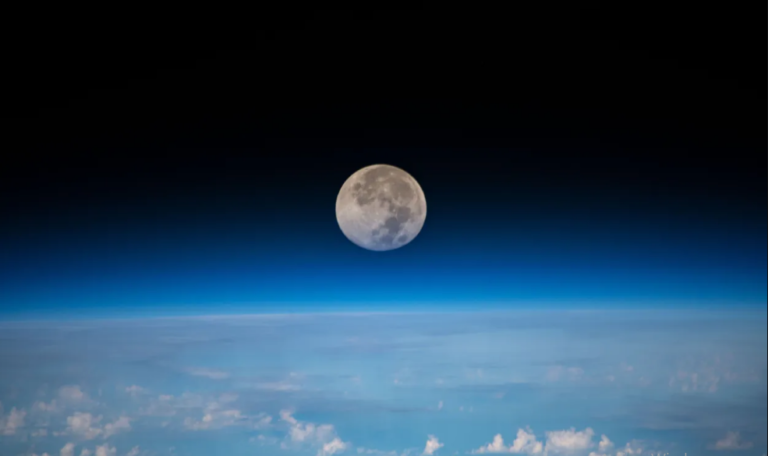NASA finds Earth’s moon didn’t need hundreds of years to form. Try hours.
People have found solace in Earth’s dependable friend, the moon, who has always marched through space with this planet as it makes its way around the sun, when it has looked like a vast and lonely place.
But 4.5 billion years ago, the moon wasn’t even a thing. And even though it is the nearest neighbor and greatest friend of Earth, scientists are still unsure of how it got there.
The prevalent idea has been that the moon was formed over a period of tens to hundreds of years by a giant planet that smashed into Earth billions of years ago. This planet may have been the size of Mars. According to a research published on Tuesday in The Astrophysical Journal Letters, the moon might have formed in a single quick collision, with a significant portion of the newborn Earth and the material from its impactor being flung into a broad orbit – in a couple of hours.
If accurate, the study, which focused on hundreds of extremely high-resolution computer models of such a collision, may help scientists answer the question of why the lunar crust resembles the Earth’s so strikingly. It also offers possible explanations for the moon’s tilt and thin outer layer. Cosmologists are eager to put together what happened in order to explain a pivotal period in the history of Earth as well as to further the account of the moon’s birth.
Attempting to illustrate how the new paradigm will operate, NASA and partners created a brief two-minute cartoon. A planet that researchers have called “Theia” throughout the years whacks a prehistoric Earth like a paintball, ejecting a variety of planetary guts in the process. But instead of separating into a tiny disk of debris, it splits into another blob, yo-yoing matter between them. The smaller body is thrown forward by the gravity of Earth, yet it survives. The umbilical cord splits.
A marimba-based musical composition that sounds soothingly soothing contrasts this destructive dancing.
As a postdoctoral researcher at NASA Ames Research Center in California and the paper’s primary author, Jacob Kegerreis joked with Mashable, “I’ve always thought it would be amazing to really have some, as it were, genuine sound effects, getting some explosions in there.”
“I’ve always thought it would be great to actually have some, as it were, real sound effects, getting some explosions in there.”
For years, scientists have done lower resolution computer simulations of the massive collision, without two entities separating. In one instance, NASA collaborated with the Institute of Computational Cosmology at Durham University in England to run simulations up to 1,000 times more detailed than the norm, testing and monitoring various crash angles, speeds, planet spins, and sizes.
The increased computational capability revealed behaviors that hadn’t been discovered in earlier studies. Researchers questioned the outcome as a numerical issue with their model because there was some previous, circumstantial evidence of a crash that may break into two blobs, Kegerreis said.
The parts of the globe are represented in this new model by hundreds of millions of microscopic particles. The system ought to function correctly, in principle, if they can precisely depict how those materials interact through gravity, pressure, and heat, he added.
Kegerreis uses the example of dropping a ball to split it apart to illustrate his point.
“That ball may just split precisely in an impossible way if you make it out of tiny Lego pieces and you only have 50 of them,” he warned. However, if there are dozens or millions of them, you could start to notice how it truly fragments in a more realistic manner and that it is the same type of notion.
Pioneering Scientists from @DarkerMatters and @NASAAmes used supercomputer simulations to reveal an alternative explanation for the #Moon‘s origin, with a giant impact immediately placing a Moon-like body into orbit around Earth.
Learn more 👉 https://t.co/OrHWUrgsvu pic.twitter.com/wwnTml6vMh
— Durham University (@durham_uni) October 4, 2022
A chemical debate prompted scientists to examine the giant-impact scenario around ten years ago. The 21st century analysis of Apollo moon samples revealed that whereas Mars meteorites and objects from other areas of the solar system have distinct compositions, lunar rocks share a chemical signature with the Earth’s mantle. That implies that non-Earth sources ought to appear much different.
They have pondered how the moon might have formed from an amalgam of Earth and a mysterious planet if there were no signs of extraterrestrial chemical characteristics.
Scientists are still debating this matter. The benefit of the new NASA computer simulation is that it produces a moon that is primarily formed of Earth-derived materials.
The making of our Moon…
A new @NASA simulation shows the Moon may have formed much faster than previously thought (over a matter of hours!) following the collision of a Mars-sized object with Earth.
Learn more about this lunar origin story: https://t.co/rzr3PMwiwm pic.twitter.com/mSoT6dO54e
— NASA Ames (@NASAAmes) October 4, 2022
It is difficult for scientists to comprehend the makeup of the moon, in part because they have only studied a small number of rocks from a small region close to its equator. The Artemis moon-landing missions, which will investigate a completely new area and collect more data and samples from deeper beneath the moon, are eagerly anticipated by NASA scientists.
The way the work offers fresh perspectives on how to think about how the moon evolved fascinates cosmologists like Kegerreis.
He added that there were probably more significant crashes before Theia, saying, “On the one side, [these events] are definitely quite violent and somewhat disruptive, but they’re also incredibly productive.” “We’re definitely fortunate that they don’t happen very often these days, but they were a critical factor in bringing the Earth to its current level of habitability.”
Do not forget to share your opinion with us to provide you with the best posts !





0 Comments